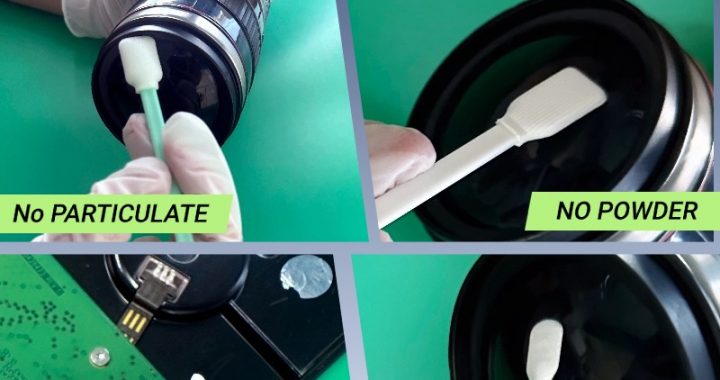Cleanroom swabs are essential cleaning tools in industries such as precision manufacturing, biotechnology, microelectronics, and optical instrumentation. Their quality directly impacts contamination control, product yield, and production efficiency. Choosing a reliable cleanroom swab manufacturer is critical for procurement professionals. This article provides a systematic selection guide based on five key dimensions: production qualifications, manufacturing capacity, testing capability, cost-performance ratio, and service support.
1. Production Environment and Raw Materials Are Fundamental
Cleanroom Grade Determines Product Purity
High-quality cleanroom swabs must be produced in ISO-certified Class 100 or higher cleanrooms (e.g., Class 10). For example, Shenzhen USTER Technology Co., Ltd. operates dedicated Class 10 and Class 100 cleanrooms. Manufacturers without such environments can only produce low-grade swabs, unsuitable for critical cleanroom applications.
Compliant Raw Materials Ensure Product Stability
Common materials include PP (polypropylene) handles combined with high-density polyurethane foam or cleanroom cloth tips. All raw materials must be certified to meet industry standards—free from harmful volatile compounds, ionic residues, halogens, or sulfur—to ensure safety in sensitive environments.
2. Manufacturing Scale Affects Delivery and Cost
Large-Scale Automated Production Ensures Supply Stability
Top-tier manufacturers typically operate over 10,000 square meters of cleanroom space with automated production lines, enabling mass production and cost control for large-volume orders.
Customization Capability Is Key for Specialized Applications
For sectors like HDD, optics, or SMT, non-standard designs such as dual-head swabs, shaped foam tips, or extended handles are often required. This demands not just manufacturing capacity but also R&D capabilities. Manufacturers like USTER have dedicated R&D teams for such flexible production.
3. In-House and Third-Party Testing Ensures Reliability
Key Performance Indicators:
-
LPC (Liquid Particle Count): Measures particle shedding in liquid environments.
-
APC (Airborne Particle Count): Indicates particle release in air.
-
IC (Ion Chromatography): Evaluates ionic content critical for microelectronics.
-
Absorbency & Residue Tests: Determine cleaning effectiveness and residue-free performance.
Third-Party Certification Builds Trust
Reliable manufacturers submit products for third-party lab certification (e.g., SGS, ROHS, REACH), enhancing customer confidence and proving product consistency.
4. Cost-Performance Balance: Not Always About the Price
International Brands: Texwipe and Berkshire
-
Advantages: Renowned quality and stability; widely used in semiconductor and medical industries.
-
Disadvantages: Expensive and long lead times; best for premium projects.
-
Ideal for: High-budget, ultra-clean applications requiring top-tier standards.
Recommended Domestic Brand: USTER
-
Advantages: Offers high-end quality at a more competitive price; many resellers and OEM partners choose USTER as a preferred supplier.
-
Market Reputation: Frequently recommended for large-scale or cost-sensitive projects without compromising on quality.
5. Service and Support Define Long-Term Value
Technical Support and Fast Response Are Crucial
Leading manufacturers offer technical consulting and product selection advice. For example, USTER has a dedicated technical support team ready to assist clients with samples, data, and custom solutions.
Logistics and After-Sales
Domestic manufacturers typically have quicker logistics. USTER partners with reliable carriers like KY Express and Deppon, ensuring fast, safe delivery with anti-static, moisture-proof packaging.
6. Final Recommendations
| Client Type | Recommended Brands | Procurement Strategy |
|---|---|---|
| Overseas High-End | Texwipe, Berkshire | Plan ahead, prioritize performance, high budgets |
| Domestic Users | USTER, Other Top Chinese | Focus on price-performance and logistics |
| Distributors/Agents | Partner with USTER, etc. | Competitive pricing, fast restocking, brand value |
Conclusion:
Though cleanroom swabs are small, they play a crucial role in contamination-sensitive environments. Choosing a supplier goes far beyond price—it’s about technical capability, testing accuracy, and responsive service. By trial sampling and small-batch testing, clients can better validate product performance before establishing long-term partnerships.
